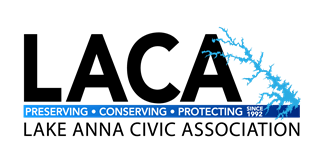By Greg Baker - April 2022
Elections
It is that time of year to solicit volunteers for the LACA Board elections which will be held this summer. If you are an old timer at the lake, a new full-time resident that wants to get involved or a weekender that can come down on the first Thursday of the month for our board meeting, LACA could sure use your help. Our goal is to have at least two volunteers on the ballet for each board position. The positions up for election this summer are Vice President, Secretary, Assistant Treasurer and the Regional Directors in the following regions: Region 2-Jackson/Cuckoo Public Side, Region 4-Brokenburg, Region 6-Mineral/Louisa.
In addition, we have a vacancy in Region 3-Partlow. We are looking for at least one person that the board might consider appointing to serve out the remainder of the term. Hopefully, we have more than one person that is willing to volunteer for this position, in which case we will hold a special election.
For the Regional Director positions, you must own property or live in the region. If you are unsure of the boundaries of the regions, you may read our policy statement that defines the boundaries. In most cases the boundaries are in line with the county voting districts. There are maps of these districts on our website as well that you can see here. Each position on the board has a term of two years.
To learn about the roles and responsibilities of those roles, by clicking the following: Regional Director Roles or Officer Roles. If being on the board is not your cup of tea, but you would like to volunteer for one of our committees, please let us know. Our standing committees are Water Quality, Environmental Preservation, Fireworks, Emergency Services & Safety, Land Use and Membership & Marketing. We can also use help in managing our website, publishing our newsletter and grant writing. There is never a shortage of opportunities to help LACA and Lake Anna.
If you are interested or would like to find out more, please email the election committee which is made of myself and Irene Luck at either greg.baker@lakeannavirginia.org or irene.luck@lakeannavirginia.org
Four Seasons RV Park
Since the Four Seasons RV Park SUP application was denied by the Planning Commission in a vote of 7-0, the application has been on the back burner waiting to be heard by the Board of Supervisors. We believe the application will reach the Board on their regularly scheduled meeting on Tuesday, May 10th at 4:30.
The rules for the Board of Supervisors meeting are different than those of the Planning Commission as it relates to the ability to speak or have an email read into the record.
John Wayne (LACA’s land use Chair) and I are working diligently to determine what we think might be the best course of action for our members to express our opposition to this application.
Please mark your calendars for May 10th and make every effort to join us in person. We will communicate on our website, through our newsletter and our timely E-Grams as we have more information. As we learn more, we will be requesting all of our members and their friends and families start an email/letter writing campaign directly to the Supervisors.
We also hope to meet with the newly elected Livingston District Supervisor, Jake Lane in the coming days to solicit his advice and input.
To be clear, every effort to date has been nothing more than a scrimmage. The ultimate outcome is up to the majority of the seven Supervisors. The real battle is yet to come on May 10th.
Jack Bertron Award Nominees Requested
It is also that time of year to solicit nominees for the “Jack Bertron Distinguished Service Award.” Annually, LACA awards an individual or an organization our highest honor/recognition for their outstanding work for the benefit of LACA or more important Lake Anna.
To learn more about the criteria for this important award, please click here or click to see a list of the past winners. There is also a terrific article about last year’s winner, Elk Creek Farm written by our very own Irene Luck.
Kick the HAB @ LKA
Please be sure to read Ron Skinner’s newsletter article about our new fundraising campaign. I hear from our members all the time that they “know” what causes HAB and we need to stop talking about it, researching it, testing it and instead, just fix it! 
I do really wish that this extremely complex problem was that easy to identify and remediate, but the issue is not an easy fix and could cost well into the hundreds of millions of dollars to permanently eradicate.
This new fundraising effort is LACA’s first attempt to execute a plan that could potentially have a measurable impact. Our goal is to treat the lake prior to HAB outbreaks with the hope of preventing or shortening VDH’s recreational no-swim advisories that have plagued the lake for the past four years.
There is much to do on this project, most importantly obtaining the proper permissions and permits from the regulatory authorities and Dominion Energy.
Our goal is to execute this plan in 2022! However, in spite of the regulatory challenges, if we are successful, we want to ACT and we cannot do that without your financial support. To have a chance of this occurring in 2022, we must meet our fund-raising goal by early June.
Our volunteer board has stepped up and agreed to match the first $35,000 in donations that we receive. Please help make us write these matching checks by donating today. Click here to make your fully tax-deductible donation to Kick HAB’s Butt! Please tell your friends and neighbors about this project and ask them to chip in as well.
greg.baker@lakeannavirginia.org

